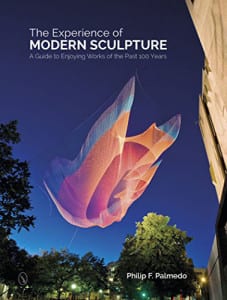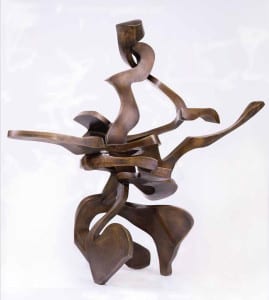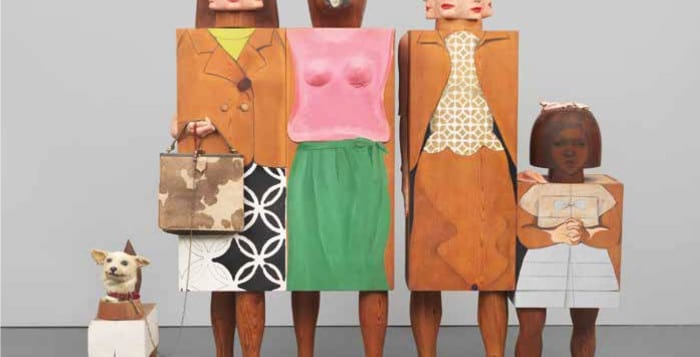By Elizabeth Kahn Kaplan
Just a few weeks ago, the Museum of Modern Art opened its exhibit, Picasso Sculpture, to critical acclaim. The exhibit is so chock full of fascinating objects that it can be daunting to take them all in properly, and so it is fortunate that Philip F. Palmedo’s latest book has appeared, just in time to guide us. The book can help even a newbie to understand, appreciate and delight in modern sculpture, not only by Pablo Picasso but by 93 other sculptors who expanded the boundaries of what is considered great art.
Enriched by 155 illustrations, and satisfactorily printed on thick glossy stock, ‘The Experience of Modern Sculpture: A Guide to Enjoying Works of the Past 100 Years’ makes a joyous introduction to the subject, with informative, user-friendly notes. It is also, with its carefully chosen bibliography, a worthy addition to the bookshelves of art historians.
Palmedo, a resident of Head of the Harbor, seamlessly achieves his objective, which is to enrich the experience of modern sculpture, “particularly for those who have found it uninteresting, mute, or simply baffling.” He guides a willing learner to experience a work’s power, originality, and, often, humor, by absorbing the artist’s purpose in its creation. We are encouraged to dismiss previously held intellectual distinctions of what is art. Palmedo believes, “The appreciation of sculpture is first of all a visual and sensuous affair. It is the encounter and the experience that are important.”
 Constantin Brancusi’s graceful “Bird in Space “(“L’Oiseau dans l’espace”), 1932–1940, is a case in point. A commanding presence of polished brass, almost 5 feet tall, it evokes the thrill we experience when a bird celebrates its freedom in flight; we need no artist to sculpt its wings or beak to confirm its identity.
Constantin Brancusi’s graceful “Bird in Space “(“L’Oiseau dans l’espace”), 1932–1940, is a case in point. A commanding presence of polished brass, almost 5 feet tall, it evokes the thrill we experience when a bird celebrates its freedom in flight; we need no artist to sculpt its wings or beak to confirm its identity.
As the 20th century progressed, sculptors began to appropriate materials that were either previously unavailable or simply not considered for use in the past. In 1909, when Picasso first transitioned within cubism from painting to sculpture, he chose bronze for the head of his mistress and muse, “Woman’s Head (Fernande).” “Contrast this with his 1942 ‘Bull’s Head’ — an assemblage of the leather seat and metal handles of a bicycle.
“No matter that the bull has an unusually pointy snout; we recognize it immediately because of its gently curved, symmetrical horns,” Palmedo writes. “The two aspects of the sculpture — the simple, familiar objects, and the form of the bull — seem to first oscillate in our consciousness and then coexist. A simple and captivating magic trick is performed before our eyes.
“You often wonder, looking at a piece of abstract sculpture, whether you are feeling what the artist intended you to feel, whether you are getting it. When you get the joke . . . in Picasso’s ‘Bull’s Head,’ you have the pleasure of knowing you are indeed connecting with the artist’s intent. You are getting it — as long as you don’t think that the joke is everything.” Both of these works are included in Picasso Sculpture at MoMA.
Another work that incorporates unusual materials along with a dose of humor was created in 1964 by Marisol — one of 15 women artists whose work is recognized in this book. Her life-size “Women and Dog,” in which the four women are said to be self-portraits, is on exhibit at the new home of the Whitney Museum of Art, and incorporates wood, plaster, synthetic polymer, a taxidermic dog head and miscellaneous items.
Palmedo likens a perfectly balanced abstract sculpture to a great musical composition. In Anthony Caro’s complex construction of bright yellow-painted steel “Fanshoal,” 1971–1972, Palmedo senses that any alteration of the relationship between the disparate parts would lessen the perfection of the whole. He likens it to a Bach partita that contains no superfluous note.
Another work, created in homage to a master of musical composition, is Kenneth Snelson’s “Mozart I,” in stainless steel, 1981–1982. Palmedo sees Snelson’s act of creating a work of art as very similar to composing music, in its clarity, lyricism and rigor of composition.

The movement of dance and music has inspired many sculptors past and present. Bill Barrett’s “Swing Dance,” 2005, of fabricated bronze, captures the vitality of a couple swept up in the music and rhythm of a boogie beat. “Capturing evanescent movement in bronze is no mean feat,” writes Palmedo, who pays tribute to Barrett’s distilled, subconscious sense of grace and melodic line.
Lin Emery’s sculpture, “Sunflower of 2009,” photographed here in motion, underscores her fascination with movement. Early in her career she used flowing water as the motive force for kinetic metal sculptures. In later works such as this, ball bearings create delicately balanced works moved by the wind. Polished aluminum surfaces resembling parts of the flower reflect the changing colors of clouds and sky, and we respond as we do to the beauties of nature. The skill of an engineer is required to achieve a kinetic work, a balancing act between beauty and the machine.
The pleasure that Palmedo derives from art in all its manifestations is a defining characteristic of his persona. He writes, “There are times looking at a sculpture when I am profoundly struck by the absolute perfection of the relationship between all of its elements and for a brief moment I experience something as close to joy that a physical object can grant.” This magnificent book brings the willing reader into that delightful state.
Palmedo will be speaking and signing copies of his book at The Long Island Museum, 1200 Route 25A, Stony Brook on Friday, Nov. 20, at 5 p.m. The book may also be purchased from the publisher, Schiffer Publishing, Ltd., the gift shop of The Long Island Museum, and at Amazon.com.





